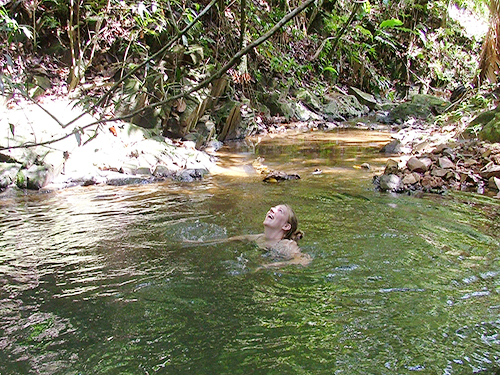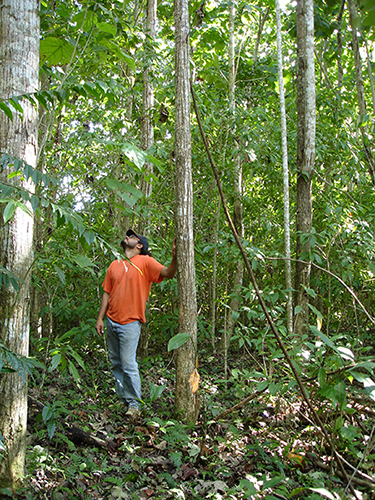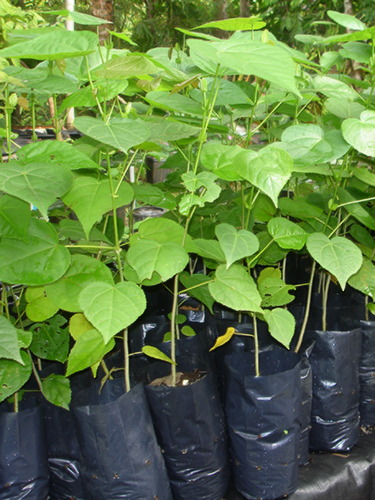Sustainability is the capacity to endure. In ecology the word describes how biological systems remain diverse and productive over time, and for forestry to be sustainable, it is obvious that it can only be accomplished on a small, human scale by those who are concerned about the forest as a total system rather than a mechanism for quick profit, which cannot be maximized in the short-term without injuring the potential of future growth and productivity.
As private forestland stewards in Puerto Rico we are careful to pay attention to the public, and listen, because forests, and large swathes of land, anywhere, regardless of who owns them, are viewed as part of a collective asset of us all.



Living on the land is the most beneficial way to practice sustainable forestry; knowing your forestland, recognizing the millions of years of evolution that have gone into perfecting a system, understanding your biospheric life-support system, having a deep commitment to the land, and the dedication to preventing degradation, are key elements necessary for the future of forests.
Learning about human community is vital, and this project, in Patillas, serves as a model to create a viable, flexible, and sustainable human community that enriches as it is enriched by its biome. The Las Casas de la Selva project has worked with a total systems approach for utilizing the forest, and the forestry enrichment project was undertaken with the goal of developing ecologically sound approaches to timber production on lands unsuited to agricultural use while maintaining or increasing forest cover and biodiversity.
Since 1983, the Puerto Rican Department of Natural & Environmental Resources (DNER) and USDA Forest Service have cooperated with this forest enrichment program, helping with seedling supply, partially covering planting costs, and giving overall advice to encourage the development of timber production in the island’s forests. The Las Casas de la Selva forestry project is registered as an Auxiliary Forest by the Department of Natural & Environmental Resources. With the assistance of the Forest Bureau of the DNER, in conjunction with the UDSA Forest Service, a Sustainable Forestry Stewardship Management Plan was developed for long-term use and conservation of the Las Casas de la Selva area. The land is a valuable natural zone, as it adjoins the 6,500 acre Carite State Forest and thus expands the continuity of rich forest habitat.
The tree-planting project was designed to test the efficacy of line-planting enrichment in the wet forest life zone as a dual means of providing both economic return and protection of natural biological resources. Nelson et al. found that vegetation and amphibian biodiversity were similar in areas of line-plantings and unplanted secondary forest at Las Casas de la Selva, 20 years after line planting. If valuable economic returns are achieved from line-planting efforts, Las Casas de la Selva will provide a model for future sustainable forestry initiatives in secondary forest management. With the current global concern for tropical deforestation, the role that this project can play in improving the understanding of tropical forests’ biology and sustainable management of secondary forests is more vital than ever.
Forest cover stabilizes soils in areas where there are steep slopes, and erosion issues created by past agricultural practices and over-grazing. Forest cover keeps sediments from silting rivers, reservoirs, and from damaging coastal marine and coral reef ecosystems. Through hydrological mechanisms, forests deeply and directly affect many island economic activities, like fishing, and all tourism that depend on healthy ecosystems. Puerto Rico’s forests provide ecotourism and recreational opportunities for a rapidly growing urban population. The forests are increasingly under pressure, and it is our profound obligation to use our resources as wisely as possible.
SILVICULTURE
Silviculture is the science of the cultivation of trees to meet diverse needs. Silviculture is a branch of the science of forestry, and different silvicultural systems are used to launch and sustain healthy forest growth, including, seed-tree, shelterwood and selection. Trees are replenished in various ways, including seeds, seedlings, and cuttings. The word silviculture is derived from the Latin word silva meaning wood and the French word culture meaning cultivation.
